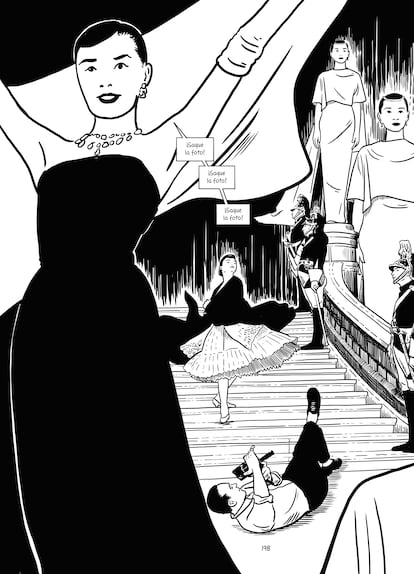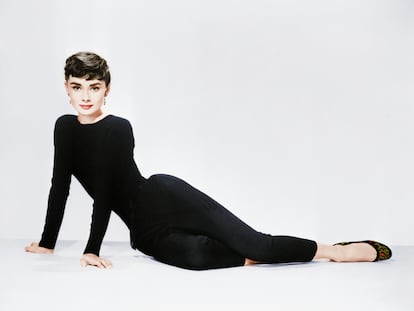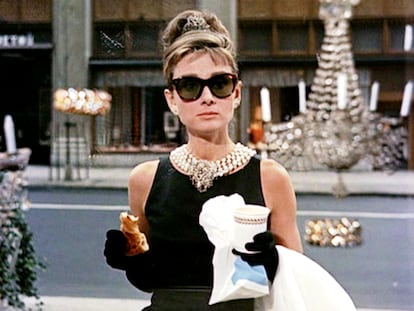Audrey Hepburn: The myth, now in comic book form
Under the watch of the actress’ youngest son, a graphic novel travels the star’s life, from her World War II childhood to humanitarian work


A square face with eyebrows. So Truman Capote defined the face of Audrey Hepburn (Brussels, 1929-Tolochenaz, 1993). Simple as it is blunt, the sarcastic comment of the writer opposed to the actress starring in the adaptation of his novel Breakfast at Tiffany’s, has now become the takeoff point from which Christopher, one of the greats of French comics, has drawn the star in the Spanish language graphic novel Audrey Hepburn (Aloha Editorial), written by Switzerland’s Eileen Hofer with the collaboration of Luca Dotti, Hepburn’s youngest son and the keeper of her secrets.
Hepburn did not have an easy childhood, even though her mother did come from a wealthy home. Her father, a gallant English trickster, left his family behind when the actress was six years old. During World War II, Hepburn lived with her mother and two half-brothers in Arnhem, in the Netherlands, where she hid her English origins by speaking Dutch exclusively. “Her parents were both Nazi sympathizers,” Eileen Hofer says via phone, from Geneva. “And although her mother eventually repented, Hepburn was traumatized by that ideological drift.”

Not to mention, poor wartime nutrition put an end to her promising future as a dancer. “The figure of Anne Frank is so present in Audrey’s story. Their age, their lived experiences of the German invasion, the geographical proximity of their homes … Hepburn could also have died during the war: she even danced to raise funds for the resistance. Due to all this, when Otto Frank proposed Hepburn to play the role of his daughter on the big screen, there was hesitation before the idea was rejected: the actress was already too old.” The volume dedicates many a page to Hepburn’s childhood and adolescence “because that’s when her personality was formed.”

Hepburn’s entire biography is suffused by that feeling of “what if?” As the writer says, “she was often in the right place at the right time.” But, Hofer insists, “luck was accompanied by her talent and perseverance. She prospered despite beauty norms, despite the establishment, even despite her husbands.” The first of these, her fellow actor Mel Ferrer, managed his wife’s career with an iron fist. “It was very interesting to write about him, because in the 1950s, women stayed at home,” Hofer says. “What’s more, women did not make more money than their husbands. Mel was older than her, had been acting for longer, and on one hand, watched over her projects, took care of his wife’s career. Although, on the other hand, he begged for small roles in her films, and that’s where the male bitterness that ended their relationship came from.”

Of course, the pages of the graphic novel also relate the story of her greatest hits — Roman Holiday, Breakfast at Tiffany’s, Charade, Funny Face, My Fair Lady, Two for the Road, Wait Until Dark, Robin and Marian — her friendship and collaborations with two geniuses, the designer Givenchy and filmmaker Billy Wilder, and of her eternal anxiety over being a good mother. “From the beginning, Christopher and I understood that we needed to have her family on our side and be able to go over details with them. There are people all around the world who know her down to every pair of pants she used in one of her films. Luca, her son by her second husband, Andrea Dotti, even gave us access to his mother and grandmother’s passports, with which we were able to pinpoint dates of trips that were contradicted by previous biographies,” says the writer. “Like his mother, he’s a humble guy, he was always available. The three of us spent many hours on Zoom calls, and Luca always thanked us for our effort. The little that we have fictionalized has been with his consent. And he corrected some mistakes, like the fact that Audrey never smoked when she walked, something that women of her generation would never do, and that we had drawn in error, and he told us anecdotes from her childhood in Italy, of the affectionate relationship between her mother and their maids, for example.”
From Italy, Hepburn emigrated in the mid-1970s to Switzerland, where she already had a house in Tolochenaz, sick of the paparazzi’s persecution and fearful that they would kidnap her children for ransom.

How do you take on a myth? “Christopher is a clean-lined draftsman, and that helps to capture Hepburn. I spent a year researching and writing. Because I had to write a book for people who didn’t know the actress, that was at the same time for her die-hard fans. For example: she only made two films with Wilder, but I watched his entire filmography in order to understand his influence from Lubitsch, and its echo in the film he made with Hepburn. She didn’t want to let anyone down, and at the end of the day, she wanted it to be understood that after living through the horrors of the Second World War, she was passionate about living a full life. Hence her work as a Unicef ambassador, to which she devoted herself in her later years. She even made a last humanitarian trip to Somalia, during her final battle with cancer.”

The creation of the carefully edited 320-page graphic novel featured the same kind of casual synchronicity as that which so often visited the life of its subject. Hofer, a longtime filmmaker, had previously written a comic book about the Cuban dancer Alicia Alonso. “A friend told me that, to resolve some doubts I had about the project, the best source would be a woman who lived in the south of France. I called, asked her my questions, and that was it. Five days later, on a Saturday morning, I went with a group of friends to Switzerland’s Morges district, a half hour from Geneva, on the shores of Lake Geneva. Scrolling the internet for things to do, I discovered that there was a ‘Hepburn trail’, that she had lived and died there, which I had had no idea. And just as we were starting it, the woman called me and explained that she had just had breakfast with her husband, the illustrator Christopher, and he was looking for a writer to make a comic about Audrey Hepburn, and she had thought of me. I started laughing, and told her about the synchronicity of the moment. That’s how the project began.”
Now Hofer, who speaks perfect Spanish after having studied at the Autonomous University of Madrid, is working on a new comic, focusing on the Chilean composer and singer Violeta Parra. “Another fateful moment, because her great love was from Geneva, where I live. She was another powerful woman, like Audrey, and another fighter against injustice and inequality.”
Sign up for our weekly newsletter to get more English-language news coverage from EL PAÍS USA Edition
Tu suscripción se está usando en otro dispositivo
¿Quieres añadir otro usuario a tu suscripción?
Si continúas leyendo en este dispositivo, no se podrá leer en el otro.
FlechaTu suscripción se está usando en otro dispositivo y solo puedes acceder a EL PAÍS desde un dispositivo a la vez.
Si quieres compartir tu cuenta, cambia tu suscripción a la modalidad Premium, así podrás añadir otro usuario. Cada uno accederá con su propia cuenta de email, lo que os permitirá personalizar vuestra experiencia en EL PAÍS.
¿Tienes una suscripción de empresa? Accede aquí para contratar más cuentas.
En el caso de no saber quién está usando tu cuenta, te recomendamos cambiar tu contraseña aquí.
Si decides continuar compartiendo tu cuenta, este mensaje se mostrará en tu dispositivo y en el de la otra persona que está usando tu cuenta de forma indefinida, afectando a tu experiencia de lectura. Puedes consultar aquí los términos y condiciones de la suscripción digital.
More information
Archived In
Últimas noticias
Most viewed
- Sinaloa Cartel war is taking its toll on Los Chapitos
- Oona Chaplin: ‘I told James Cameron that I was living in a treehouse and starting a permaculture project with a friend’
- Reinhard Genzel, Nobel laureate in physics: ‘One-minute videos will never give you the truth’
- Why the price of coffee has skyrocketed: from Brazilian plantations to specialty coffee houses
- Silver prices are going crazy: This is what’s fueling the rally










































